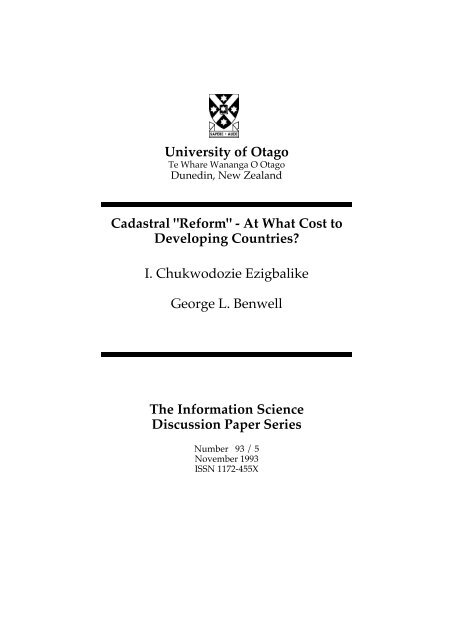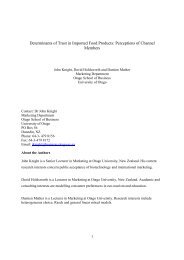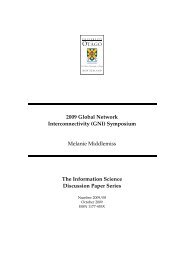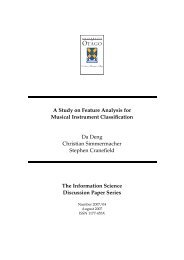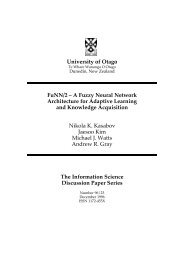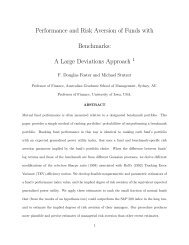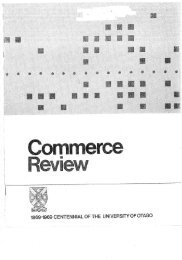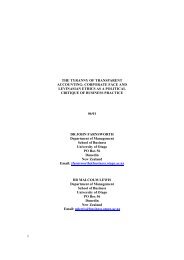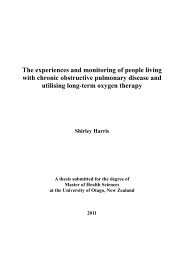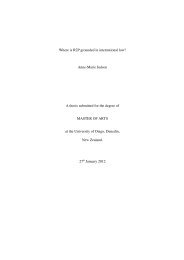University of Otago Cadastral - Otago University Research Archive
University of Otago Cadastral - Otago University Research Archive
University of Otago Cadastral - Otago University Research Archive
Create successful ePaper yourself
Turn your PDF publications into a flip-book with our unique Google optimized e-Paper software.
<strong>University</strong> <strong>of</strong> <strong>Otago</strong><br />
Te Whare Wananga O <strong>Otago</strong><br />
Dunedin, New Zealand<br />
<strong>Cadastral</strong> "Reform" - At What Cost to<br />
Developing Countries?<br />
I. Chukwodozie Ezigbalike<br />
George L. Benwell<br />
The Information Science<br />
Discussion Paper Series<br />
Number 93 / 5<br />
November 1993<br />
ISSN 1172-455X
<strong>University</strong> <strong>of</strong> <strong>Otago</strong><br />
Department <strong>of</strong> Information Science<br />
The Department <strong>of</strong> Information Science is one <strong>of</strong> six departments that make up the Division <strong>of</strong> Commerce at the<br />
<strong>University</strong> <strong>of</strong> <strong>Otago</strong>. The department <strong>of</strong>fers courses <strong>of</strong> study leading to a major in Information Science within the<br />
BCom, BA and BSc degrees. In addition to undergraduate teaching, the department is also strongly involved in<br />
postgraduate programmes leading to the MBA, MCom and PhD degrees. <strong>Research</strong> projects in s<strong>of</strong>tware engineering<br />
and s<strong>of</strong>tware development, information engineering and database, artificial intelligence/expert systems, geographic<br />
information systems, advanced information systems management and data communications are particularly well<br />
supported at present.<br />
Discussion Paper Series Editors<br />
Every paper appearing in this Series has undergone editorial review within the Department <strong>of</strong> Information Science.<br />
Current members <strong>of</strong> the Editorial Board are:<br />
Mr Martin Anderson<br />
Dr Nikola Kasabov<br />
Dr Martin Purvis<br />
Dr Hank Wolfe<br />
Dr George Benwell<br />
Dr Ge<strong>of</strong>f Kennedy<br />
Pr<strong>of</strong>essor Philip Sallis<br />
The views expressed in this paper are not necessarily the same as those held by members <strong>of</strong> the editorial board. The<br />
accuracy <strong>of</strong> the information presented in this paper is the sole responsibility <strong>of</strong> the authors.<br />
Copyright<br />
Copyright remains with the authors. Permission to copy for research or teaching purposes is granted on the condition<br />
that the authors and the Series are given due acknowledgment. Reproduction in any form for purposes other than<br />
research or teaching is forbidden unless prior written permission has been obtained from the authors.<br />
Correspondence<br />
This paper represents work to date and may not necessarily form the basis for the authors’ final conclusions relating<br />
to this topic. It is likely, however, that the paper will appear in some form in a journal or in conference proceedings<br />
in the near future. The authors would be pleased to receive correspondence in connection with any <strong>of</strong> the issues<br />
raised in this paper. Please write to the authors at the address provided at the foot <strong>of</strong> the first page.<br />
Any other correspondence concerning the Series should be sent to:<br />
DPS Co-ordinator<br />
Department <strong>of</strong> Information Science<br />
<strong>University</strong> <strong>of</strong> <strong>Otago</strong><br />
P O Box 56<br />
Dunedin<br />
NEW ZEALAND<br />
Fax: +64 3 479 8311<br />
email: workpapers@commerce.otago.ac.nz
-<br />
<strong>Cadastral</strong> "Reform" At What Cultural Costs<br />
to<br />
Developing Countries?<br />
Dr I. Chukwudozie Ezigbalike<br />
Department <strong>of</strong> Surveyingand Land Information<br />
<strong>University</strong><br />
<strong>of</strong> Melbourne<br />
Dr George L. Benwelll<br />
Spatial Information <strong>Research</strong> Centre<br />
<strong>University</strong> <strong>of</strong> <strong>Otago</strong><br />
December 1993<br />
Abstract<br />
This paper argues that the introduction <strong>of</strong> western cadastral concepts<br />
into communities with different land tenure systems<br />
have involved<br />
c u l t u r a l c o s t s . The paper discusses these cultural costs and<br />
concludes that cadastral reformers need to<br />
re-design their product<br />
the communities.<br />
to fit<br />
1<br />
Address correspondence to: Dr G.L. Benwell, Director, Spatial Information <strong>Research</strong> Centre, <strong>University</strong> <strong>of</strong><br />
<strong>Otago</strong>, P.(). Box 56, Dunedin, New Zealand. Fax: +64 3 479 8311 Email: gbenwell@commerce.otago.ac.nz<br />
1
~<br />
I<br />
Introduction<br />
National land laws are usually justified<br />
in the name <strong>of</strong><br />
agricultural d e v e l o p mTheir e n t introduction _<br />
followed the disparagement <strong>of</strong> indigenous<br />
. . has<br />
<strong>of</strong>ten<br />
land tenure<br />
systems as c o n s t r a i n to t s commercialization which needed<br />
to be removed. E x p e r t then, s , propose land tenure<br />
r e f o r m s designed <br />
to sweep away<br />
[Reyna and Downs l988, 9]<br />
the constraints.<br />
<strong>Cadastral</strong> reform refers to planned and programmed changes to the cadastral system in a<br />
specific jurisdiction designed to improve its performance. Williamson [l990, 11] notes<br />
that it is c o n c e r n e dwith improving the operation, efficiency, effectiveness and<br />
performance <strong>of</strong> the cadastral system in a state or j u r i s d i c t iThe o n word . r e f o r m implies <br />
that a cadastral system already exists and changes are being introduced to improve it.<br />
Conditions which necessitate change, and what constitutes improvement will depend on<br />
actual jurisdictions. Some <strong>of</strong> the reasons for reform would include (for a more detailed<br />
discussion <strong>of</strong> reasons for cadastral reform, see, for example, Williamson 1990; Dale 1990;<br />
Robertson 1990; Fitzgerald 1990):<br />
changes in tenure arrangements as a result <strong>of</strong> social and/or political reforms, as is<br />
now<br />
taking place in Eastem Europe;<br />
exploiting new and more efficient technologies, e.g., use <strong>of</strong> electronic data and<br />
information<br />
processingdevices;<br />
a realisation that the existing system does not meet the requirements<br />
<strong>of</strong> the<br />
administrators <strong>of</strong> land-based and land-related resources;<br />
the need to improve the ease and security<br />
fostering economic and social development.<br />
<strong>of</strong> transactions in land as a means <strong>of</strong><br />
Of the above and other reasons for cadastral reform, the reasons most relevant and cited for<br />
developing countries are the latter two: the need to facilitate the administration <strong>of</strong> land<br />
resources, and to make land holdings<br />
more secure so that land owners can obtain<br />
development funds on the basis <strong>of</strong> their land titles. While better administration <strong>of</strong> land is a<br />
desirable objective, the interests <strong>of</strong> the administrators are not always aligned<br />
with the<br />
2
--<br />
from<br />
interests <strong>of</strong> the owners <strong>of</strong> the land. Also, the standard used to measure these<br />
i m p r o v e mhave e n t been s foreign, westem-focussed standards that may not tit the cultural<br />
environments they were being introduced into and the expected d e v e l o p may<br />
e nnot<br />
t <br />
necessarily materialise.<br />
This paper raises questionsrelating to cultural costs incurred in adopting European styled<br />
cadastral systems in non-European jurisdictions. The paper examines the relationship<br />
between the cadastrl and the land tenure systems<br />
a western point <strong>of</strong> view, since<br />
the concepts did not exist in d e v e l o pjurisdictions. i n g <br />
Next the paper examines<br />
customary land tenure with examples<br />
from Africa and New Zealand. Then follows a<br />
section on the main cultural costs involved in cadastial r e f o r m . The paper concludes with<br />
a recommendation that it is not the cadastral system which should be reformed, rather,<br />
reformers should emphasise the need for information for development, which will normally<br />
include tenurial information.<br />
2 The <strong>Cadastral</strong> System as a Component <strong>of</strong> the Land Tenure System<br />
Land tenure is the collection <strong>of</strong> relationships which exists between the members <strong>of</strong> a society<br />
by virtue <strong>of</strong> their occupation<br />
and use <strong>of</strong> land. It embraces:<br />
institutional arrangements pertaining to property rights<br />
and duties. It also<br />
refers to the division <strong>of</strong> decision making among tenure groups,<br />
as owners<br />
and users <strong>of</strong> land combined with other means <strong>of</strong> production. These<br />
institutional arrangements may be legally established, customary,<br />
or<br />
enforced by a combination <strong>of</strong> both. They define the rights <strong>of</strong> property<br />
owners and users. [El-Ghonemy 1990, 81-82]<br />
Land tenure systems embody the arrangements whereby individuals or organisations gain<br />
access to economic or social opportunities through<br />
land. The various institutions <strong>of</strong> land<br />
tenure are instrumental in shaping the pattem <strong>of</strong> income distribution within a community<br />
[Ratcliffe 1976, 21]. lt is therefore an aspect <strong>of</strong> the social system, and, e s p e c in i a l l y<br />
agrarian societies, exerts a considerable influence on the structure and function <strong>of</strong> social<br />
s y s t e [Gadalla m s 1962, l2]. A system<br />
the proprietary land units, a degree <strong>of</strong> flexibility and security<br />
<strong>of</strong> land tenure establishes and maintains the size <strong>of</strong><br />
to use the land and incentives<br />
and opportunities for the use. It concems the complicated collection <strong>of</strong> rights to use space.<br />
’l‘hese tights and privileges are curtailed by certain restrictions. The rights relating<br />
ownership include [Ratcliffe 1976, 22]:<br />
to land<br />
3
~<br />
the<br />
1 _ a<br />
surface right which permits a landowner to enjoy the current use <strong>of</strong> the land;<br />
2. a productive right which allows an owner to make a pr<strong>of</strong>it<br />
from current use <strong>of</strong> the<br />
land;<br />
3. a development right allowing the owner to improve the property;<br />
4. a pecuniary right whereby a landowner benefits financially from development value<br />
both actual and anticipated;<br />
5. a disposal right allowing an owner to dispose<strong>of</strong> the land.<br />
All these rights may vest in one person or different rights may vest in different persons.<br />
Also the rights and privileges are subject to restrictions imposed by law, custom or nature.<br />
There are therefore restrictive rights which vest in the society at large,<br />
in the community. For example, the physical contiguity or proximity<br />
and other individuals<br />
<strong>of</strong> one unit <strong>of</strong> land to<br />
another creates obligations on a landowner, and a complementary right, in the neighbour,<br />
and vice versa.<br />
The operation <strong>of</strong> a land tenure system is therefore dependent on the institution <strong>of</strong> property<br />
because the rights have no meaning if they cannot be enforced. The rights are enforced by<br />
society or the state [Macpherson l978}. The land tenure system<br />
therefore includes<br />
components for the enforcement <strong>of</strong> the rights by the society and the general administration<br />
<strong>of</strong> the system. These components may include tools for maintaining information about<br />
both the nature <strong>of</strong> the rights and the extent <strong>of</strong> the land in which they<br />
exist. In literate<br />
societies, this administrative Component will usually include a system for maintaining a<br />
methodical record <strong>of</strong> the interests in parcels <strong>of</strong> land in the jurisdiction. If this record is<br />
public, and meets other criteria, it is called the cadastre, and the facilities and resources<br />
employed in its maintenance constitute the cadastral system. They include:<br />
resources, techniques and methods for delineating and demarcating the parcels <strong>of</strong><br />
land within which the interests exist,<br />
the cadastrai record<br />
-_<br />
graphical and textual data describing the land parcels and<br />
the interests<br />
in them, and<br />
an identification code for linking the record with the physical parcel.<br />
4
In theory, the introduction <strong>of</strong> a cadastral system is not supposedto create new interests in<br />
land, nor abolish existing ones. It is only supposedto ascertain and record the interests<br />
recognised by the land tenure arrangements. Reform <strong>of</strong> an existing system<br />
should be<br />
expected to have even less effect on the land tenure arrangements. However, components<br />
in a systemic relationship respond to changes in neighbouring components. The cadastral<br />
system is part <strong>of</strong> the overall land tenure system. <strong>Cadastral</strong> reform is designed to improve<br />
the operation and efficiency <strong>of</strong> the cadastral system. It therefore affects the administration<br />
<strong>of</strong>, and transfer <strong>of</strong> interests in land. It may lead to more secure title or faster land<br />
transactions. More secure title and easier transactions may<br />
translate into more economic<br />
activity on the land. It therefore provides more incentive and opportunitiesfor landowners<br />
to invest, with pecuniary advantages. These in turn may translate into income<br />
redistribution and changes in power relationships derived from the ownership<br />
<strong>of</strong> land.<br />
In practice, therefore, changes in cadastral arrangement do affect the land tenure<br />
arrangements. This is in spite <strong>of</strong> declarations that r e g i s t r<strong>of</strong> a ttitle i o nis a system<br />
<strong>of</strong> record<br />
and not a new substantive land l a w [Dowson and Sheppard 1956, 72]. In fact, land<br />
registration laws have been used to effect changes in property rights and [ t h Torrens e<br />
system was intended] to get rid <strong>of</strong> much <strong>of</strong> the obscurity and complexity<br />
inherent in<br />
English land l a w [Simpson 1976, l68]. Simpson suggests that title registration i s<br />
particularly needed in those countries where it is necessary to unify the law applying to<br />
those titles granted by Government in the days<br />
<strong>of</strong> colonial rule and those titles which have<br />
developed under customary law (or in spite <strong>of</strong> i t ) . Reform <strong>of</strong> the cadastral system should<br />
therefore consider possible effects on the land tenure system. This paper argues that some<br />
<strong>of</strong> these changes are not necessarily positive in developing countries.<br />
3 Modernising Customary Land Tenure<br />
3.1 Customary<br />
Land Tenure<br />
Customary land tenure is the system <strong>of</strong> land holding<br />
and land use which derives from the<br />
operations <strong>of</strong> the traditions and customs <strong>of</strong> the people affected. Customary<br />
law derives<br />
from the accepted practices <strong>of</strong> the people and the principles underlying such practices.<br />
Another source <strong>of</strong> customary law is from rules made by chiefs in response to specific<br />
situations, e.<br />
g., draught or war, which once<br />
acceptedby the people become c u s t o m even <br />
after the situation which prompted the rule has passed. In some countries, the colonial<br />
authorities established customary courts and other local authorities which had the power to<br />
5
declare customary laws. With the introduction <strong>of</strong> the modem state and associated legal<br />
traditions, much <strong>of</strong> legal custom has evolved into case law and enacted law, and some<br />
principles which were established by legislation have filtered back into the c u s t o m . <br />
A suggested definition <strong>of</strong> customary land tenure is:<br />
The rights to use or to dispose <strong>of</strong> use~rightsover land which rest neither<br />
on the exercise <strong>of</strong> brute force, nor on evidence <strong>of</strong> rights guaranteed by<br />
government statute, but on the fact that they are recognized as legitimate by<br />
the community, the rules governing the acquisition<br />
and transmission <strong>of</strong><br />
these rights being usually explicit and generally known though normally<br />
not recorded in writing. [quoted in Simpson 1976, 223]<br />
The unwritten nature <strong>of</strong> customary laws, including those relating to land, is changing i n<br />
view <strong>of</strong> the rapid advance in education and literacy, and also in the mechanics <strong>of</strong> record~<br />
keeping [Simpson 1976, 222]. Armstrong [1992] used the term t r a d i t i o n atol refer<br />
to those aspects <strong>of</strong> customary laws which t h ehave y been told were the customs <strong>of</strong> their<br />
people in the p<br />
a s t . <br />
The most important feature <strong>of</strong> traditional land tenure is the predominance<br />
<strong>of</strong> communal<br />
ownership <strong>of</strong> whatever rights exists in any land. A question that naturally<br />
arises is the<br />
nature <strong>of</strong> the rights <strong>of</strong> each member <strong>of</strong> the land owning group in the communal property.<br />
Does each person hold a separate individual interest over the whole land or an<br />
aliquot<br />
portion <strong>of</strong> it? Or does the community constitute a land owning corporate entity? Nwabueze<br />
[1972, 53-54} contrasts the rights <strong>of</strong> members <strong>of</strong> the community<br />
or joint tenants under English law:<br />
with those <strong>of</strong> co-owners<br />
There is perhaps no rule <strong>of</strong> customary law that is more<br />
firmly established<br />
than that no member <strong>of</strong> a<br />
land-owningcommunity or family has a<br />
separate<br />
individual title <strong>of</strong> ownership to the whole or any part <strong>of</strong> the communal<br />
land. Indeed the constitution <strong>of</strong> the community, village or family for<br />
purposes <strong>of</strong> land ownership<br />
ownership quite untenable.<br />
makes such a view <strong>of</strong> the nature <strong>of</strong> communal<br />
The alternative <strong>of</strong> regarding the community, village or family as a<br />
corporate entity, distinct from its members, must also be rejected. With<br />
regard to the community or village it is necessary to<br />
distinguish its social<br />
from its political aspects. lt is the community or family<br />
as a social unit<br />
which is pre-eminently important for this purpose; in this capacity the<br />
6
1<br />
community, village or family is not a corporate entity in law, but merely a<br />
society or collection <strong>of</strong> persons with a common interest in land, all <strong>of</strong><br />
whom are jointly, severally and directly liable for debts properly incurred<br />
on behalf <strong>of</strong> the land. [Nwabueze 1972, 53-54]<br />
Another important feature <strong>of</strong> traditional land tenure are the variations in the rights and<br />
concepts which exist in different localities. In some traditional societies, land w a s<br />
considered a natural endowment in the same category<br />
as rain, sunlight and the air we<br />
b r e a t h e [Moyana 1984, l3]. Because <strong>of</strong> this view <strong>of</strong> land, it has been held by some<br />
writers that sale <strong>of</strong> land was forbidden. However, there is a more convincing argument<br />
that t h o uoutright g h alienation was uncommon in the past, it was not positively forbidden<br />
by customary l a w [Nwabueze 1972, 551. Moyana [l984, 13] suggests<br />
that there was n o<br />
limit to the amount <strong>of</strong> land one could cultivate as land was always available in large<br />
q u a n t i t iThe e s . population <br />
was scant then and the needs <strong>of</strong> the community<br />
simple and concerned mostly<br />
with subsistence.<br />
then were<br />
Another reason why alienation <strong>of</strong> communal land was not encouraged<br />
was due to the<br />
fluctuating and mythical constitution <strong>of</strong> the community, village or family. Okoro [1966]<br />
reports that Gboteyi, the Elesi <strong>of</strong> Odogbolu testified that l a n d belongs to a vast family <strong>of</strong><br />
which many<br />
are dead, few are living<br />
and countless members are still u n b o r n . A <br />
view is expressed by Sarbah on Fanti (Ghana) customary law:<br />
customary law says they who are born and they<br />
who are still in the<br />
womb require means <strong>of</strong> support, where<strong>of</strong> the family land and possessions<br />
must not be wasted or squandered.[Sarbah, quoted in Okoro 1966, 3]<br />
similar<br />
An important point <strong>of</strong> difference between various communities is the concept <strong>of</strong> ownership<br />
and <strong>of</strong> what is owned. Still following from the concept <strong>of</strong> land as natural endowment, it<br />
was sometimes a s s o c i a t ewith d sacredness as such Shona terms as p a s i c h i and g a r e <br />
D z i v a gwhich u r u <br />
are commonly used in Shona religious circles would s u g g e[Moyana<br />
s t <br />
1984, 13). In Nigeria, land was the subject <strong>of</strong> allodial or absolute ownership,<br />
to qualified ownerships or estates in English law. However, the Privy<br />
that the temi ownership is loosely<br />
in contrast<br />
Council observed<br />
used in West Africa: S o m e t i m eitsdenotes what is in<br />
effect absolute ownership; at other times it is used in a context which indicates that the<br />
reference is only to rights <strong>of</strong> o c c u p a n{Nwabueze c y 1972, 26). Also, because <strong>of</strong> the<br />
communal nature <strong>of</strong> the ownership, and the rights <strong>of</strong> future generations, whatever right a<br />
group has in land is infinite and perpetualin duration.<br />
7
3.2 Africa: Evolution or Mutation?<br />
The cadastral system exists as a<br />
component <strong>of</strong> the land law and/or land administration<br />
system. In customary land tenure jurisdictions, the rules governing the rights, privileges<br />
and obligations regarding land use, and the administration <strong>of</strong> the land were usually not<br />
recorded. Transfers <strong>of</strong> interests in land were usually accompaniedby ceremonies and/or<br />
feasts which make such transfer p u b l i c knowledge. Concepts relating<br />
to cadastral<br />
system, as the colonial administrators knew them, did not exist in the cultural complex <strong>of</strong><br />
the societies. The existing land tenure concepts did not make for easy administration by the<br />
colonisers. One <strong>of</strong> the main motivations for land reform is to facilitate the administration <strong>of</strong><br />
land. The traditional land tenure<br />
systems, with its local variations and uncertainty <strong>of</strong> all the<br />
members <strong>of</strong> the land owning group, therefore qualifies for r e f o r m The indigenous land<br />
tenure<br />
arrangements were therefore interpreted in European terms or, where they<br />
be interpreted, replaced with new Europeanarrangements.<br />
could not<br />
These European-inspired law codes and concepts, including land registration laws, did not<br />
provide for many rights which existed under traditional land law. These customary rights<br />
could not be accommodated by the wholesale introduction <strong>of</strong> western~styled land<br />
registration systems. It was<br />
recognised that while some <strong>of</strong> these rights might appear to be<br />
harmful to economic development, many <strong>of</strong> them were found to be so<br />
strongly entrenched<br />
in the social organisation <strong>of</strong> the communities that a<br />
summary abolition <strong>of</strong> them might almost<br />
destroy the very fabric <strong>of</strong> society, and might throw up far greater social and economic<br />
problems than it could hope to solve:<br />
It is preferable that the natural evolution <strong>of</strong> land tenure should not be<br />
arbitrarily interfered with, either on the one hand by introducing foreign<br />
principles and theories not understood by the people,<br />
or on the other hand<br />
by arresting progress in evolution, by stereo-typing by legislation<br />
primitive systems which are in a transitional state. Each advance should be<br />
duly sanctioned by native law and custom, and prompted by the necessity<br />
<strong>of</strong> changing circumstances [Lord Lugard, quoted in Obenson 1977]<br />
This u n i l e a le v o l u t i o n i sphilosophy m <br />
was predicated on the belief that the changes meant<br />
progress because it can b etraced in every civilization known to m a n wrote , <br />
Sir F.J.D.<br />
[later lord] Lu gard in The Dual Mandate in British Tropical Africa [quoted in Shipton<br />
1988, 96]. This philosophy was reflected in the land laws introduced in West Africa by the<br />
8
British, where elders and traditional administrators were called as expert witnesses on<br />
traditional law and customs.<br />
Of all the supposed ills <strong>of</strong> the customary systems <strong>of</strong> land tenure, the feature considered<br />
most serious was<br />
group<br />
or communal ownership <strong>of</strong> land, and private ownership was<br />
considered progress<br />
to be encouraged. Communal ownership, however, is very resilient<br />
and would not evolve away. Two main reasons account for its resilience. First is the<br />
kinship and lineage organisation <strong>of</strong> society whereby descendants <strong>of</strong> a common ancestor live<br />
together and discourage i m m i g r ainto t i o<br />
their<br />
n community.<br />
The second is that a c c e s to s<br />
land in most <strong>of</strong> rural Africa continues to be determined by indigenous systems<br />
<strong>of</strong> land<br />
t e n u r e [Bruce l988]. The most important<br />
source <strong>of</strong> land rights is by inheritance. Before<br />
the introduction <strong>of</strong> the European concept <strong>of</strong> testacy, which is still not very commonly<br />
observed, a m a n sland rights upon his death either devolved upon his children as family<br />
property<br />
or reverts to a communal pool for reallocation by the responsible authorities.<br />
Nwabueze [l972, 45-46] notes that, in Nigeria, the devolution <strong>of</strong> the property upon<br />
children a p p lwith i e s equal force even where the property has been acquired and held by<br />
the intestate under English law. The operation <strong>of</strong> this rule imposes a severe limitation upon<br />
the process <strong>of</strong> individualisation; for it means that whatever progress is made in one<br />
generationis stultified in the n e x t . <br />
It is therefore not surprising that the natural evolution approach will not be supportedby<br />
all. Simpson {l976, 226] suggests that because t h e pace <strong>of</strong> political,<br />
change in the modern world has been so rapid that there simply<br />
social and economic<br />
has not been time for<br />
evolution", it may p r o vnecessary to<br />
e replace customary law rather than wait for it to<br />
e v o l v e . This latter approach was followed in Kenya where i nthe 1950s, the decision<br />
was taken, as a matter <strong>of</strong> major Government policy, to convert customary<br />
tenure to full<br />
individual ownership in order to promote the agricultural development which the<br />
uncertainty <strong>of</strong> customary tenure i n h i b i t e[Simpson d 1976, 2001.<br />
The usual outcomes have tended to be the provision <strong>of</strong> dual systems<br />
in which some lands<br />
are held under customary tenure while others are held under m o d e r n tenure. <br />
owners are encouraged to c o n v e r t to<br />
the m o d e r n system in order to gain certain<br />
advantages, like access to development loans. The result is that informal arrangements,<br />
outside the ambits <strong>of</strong> the law, generally develop as people strive to get the best <strong>of</strong> the old<br />
andthe new. The cadastral system does not only have to deal with concepts not provided<br />
Land<br />
9
for in the original design, but also with these new developments, which even the people<br />
cannot<br />
interpret.<br />
3.3 New Zealand: Possession vs<br />
Ownership<br />
Communal ownership <strong>of</strong> land in contemporary times has come to denote wealth and<br />
associated status in the community. It is rarely a sign <strong>of</strong> anything more than an arbitrary<br />
social standing. In other times and places, for example pre European occupation<br />
<strong>of</strong> New<br />
Zealand, land has been associated with Mana. Mana is,<br />
the enduring, indestructible power <strong>of</strong> the gods.<br />
It is the sacred fire that is<br />
without beginning and without end. In modern times the term has<br />
taken on various meanings, including the power <strong>of</strong> the gods, the power <strong>of</strong><br />
ancestors, the power <strong>of</strong> the land, and the power <strong>of</strong> the individual. [Barlow<br />
l99l|<br />
Barlow goes on to say, m a n awhenua [whenua, meaning land] is the power associated<br />
with land; it is also the power associated with the ability <strong>of</strong> the land to produce the bounties<br />
<strong>of</strong> nature. When the world was created, the gods implanted this procreative power within<br />
the womb <strong>of</strong> Mother Earth. By the power <strong>of</strong> mana mauri all things have the potential for<br />
growth and development towards maturity. There is another aspect to the power <strong>of</strong> land: a<br />
person who possess land has the power to produce a livelihood for family and tribe, and<br />
every effort is made to protect these r i g h t s . <br />
lt is paramount that the present meaning <strong>of</strong> p o w eisr not confused with the meaning <strong>of</strong><br />
the word in the context <strong>of</strong> B a r l o w s quotes. The difference is subtle but important. Maori<br />
power has more to do with mana, respect, responsibility and leadership for people rather<br />
than power for the exclusion and dominance <strong>of</strong> people. Power is a<br />
responsibility<br />
not to be<br />
used to dominate others and render them subservient. So it is wrong to assume that land<br />
ownership (guaranteed by the state) within a modem cadastral system<br />
will enhance mana.<br />
Quite the reverse. Land ownership is guaranteed to the extent that it precludesownership<br />
by others; which is the reverse <strong>of</strong> the intent <strong>of</strong> Mana Whenua..<br />
There is a<br />
recognition that colonialists have failed to understand the important<br />
nuances <strong>of</strong><br />
indigenous possession <strong>of</strong> land. Crocombe, writing<br />
edited by Lundsgaarde, comments that,<br />
in L a n dTenure in G c e a n i a (pl6) <br />
I0
A common problem following European contact is that the colonizing<br />
group grasps the vital pattern but does not fully understand (or<br />
consciously ignores) all the subsidiary processes at workin the system.<br />
[quoted in Manatu Maori 1991, 13]<br />
Crocombe goes on to depict a series <strong>of</strong> rights <strong>of</strong> access, <strong>of</strong> use, <strong>of</strong> control, <strong>of</strong> transfer and<br />
so on which may be found in tribal societies. Such a typology provides<br />
a much better fit<br />
with what is known <strong>of</strong> pre Pakeha Maori land tenure usage than the word ownership in<br />
English practice,<br />
with its connotations <strong>of</strong> the exclusive exercise <strong>of</strong> all rights<br />
property in question.<br />
over the<br />
In part these concems have been addressed by the Maori Land Court and the acceptance <strong>of</strong><br />
Maori land. Maori land being land under the jurisdiction<br />
Land Court for the possession(avoiding the word o w n e r s hbyi p Maori. )<br />
and administration <strong>of</strong> the Maori<br />
Its registration<br />
is administered under the Maori Land Act and is a<br />
separate system running in parallel with<br />
the Torrens<br />
System.<br />
There may be an irresponsible tendency<br />
duality but Stokes provides a poignant warning:<br />
to comment on the success or otherwise <strong>of</strong> this<br />
It can not be assumed that one can move into the Maori world and ferret<br />
out interesting information which is then recognised and published for the<br />
edification <strong>of</strong> the world at large. It can not be assumed that research is as<br />
simple as that in the Pakeha world either. However, too many Pakeha<br />
researchers fail to see or understand that there are other dimensions to the<br />
value <strong>of</strong> knowledge; that the perceived purpose <strong>of</strong> the research may be<br />
irrelevant in Maori terms; that the Maori g u i n ep ai gprovide s <br />
answers<br />
they cooperate<br />
at all), which they think the researcher wants, out <strong>of</strong><br />
politeness and hospitality;<br />
or may even occasionally deliberately distort<br />
responses according to a Maori logic not perceived or understood by the<br />
researcher. [Stokes 1985]<br />
(if<br />
For an in-depth understanding<br />
<strong>of</strong> Maori land and land related culture the reader is referred<br />
to the seminal work by Kawharu {f1977].<br />
ll
4 Issues Relating<br />
to Cultural Costs<br />
4.1 Acculturation and Cultural Cost<br />
Culture refers to the c o m p whole l e x which includes knowledge, belief, art, morals, law,<br />
custom, and any other capabilities and habits acquired by [a person] as a member <strong>of</strong><br />
s o c i e[quoted t y in Harris 1985, l14]. It refers to, among other things,<br />
prevailing modes <strong>of</strong> dress; routine living habits; food preferences; the<br />
architecture <strong>of</strong> houses and public buildings; the layout <strong>of</strong> fields and farms;<br />
and systems <strong>of</strong> education, govemment, and law. Thus, culture is an aliencompassing<br />
term, which identities not only the whole lifestyle <strong>of</strong> a<br />
people but also the prevailing values and beliefs. [de Blij and Muller 1986,<br />
136].<br />
Culture is not static. Simpson [1976, 226] points out that a l lsocieties would develop or<br />
adapt older institutions to cope with new s i t u a t i o n s These . changes occur especially when<br />
a<br />
society<br />
comes into contact with other societies with different cultural traits. In such<br />
contacts, traits <strong>of</strong> the stronger culture are usually adopted by<br />
the weaker. The weaker<br />
culture may only undergo minor changes, or it may be substantially changed. During<br />
acculturation, as the process is called,<br />
certain societies have been fortunate enough<br />
to be able to select those<br />
elements <strong>of</strong> an alien culture to be adopted, but others have experienced<br />
acculturation through superimposition. To a<br />
greater <strong>of</strong> lesser degree, the<br />
recent history <strong>of</strong> much <strong>of</strong> America, Africa, Asia, and Australia has been a<br />
history <strong>of</strong> Europeanization, as the beliefs, values and practices <strong>of</strong><br />
European cultures were imposed on indigenous societies. [_deBlij and<br />
Muller 1986, 149]<br />
A cultural cost is incurred when the adoption<br />
<strong>of</strong> an alien culture trait results in a net<br />
disadvantage for the weaker society. Thus when a<br />
society gives up its nutritionally<br />
balanced diet for the r i c h e r diet <strong>of</strong> a dominant culture, they may<br />
incur a cultural cost when<br />
dietary iilnesses previously unknown in the society start occurring. Colonialists introduced<br />
European culture traits in developing countries mostly to facilitate their administration, but<br />
also because they regarded some <strong>of</strong> the culture traits <strong>of</strong> the colonies as inferior. Among the<br />
European culture traits introduced were language, religion, and land law and tenure<br />
arrangements. These changeshave exacted some cultural costs on the people.<br />
12
4.2 Facilitation <strong>of</strong> Credit<br />
Most land reform policies are occasioned by a need to improve agriculttual productivity.<br />
And among all arguments cited for land tenure reform, facilitation <strong>of</strong> agricultural<br />
credit is<br />
the most common. T h eargument is that having private titles will help farmers develop<br />
their holdings by giving them something to mortgage<br />
as collateral for l o a n s [Shipton <br />
l988, 119-20). Field research in Kenya, where this policy was <strong>of</strong>ficially pursued, shows<br />
that farmers still refuse, o nprinciple or on economic calculation, to entertain the notion <strong>of</strong><br />
land m o r t g a[Shipton g e s 1988, 1201. While European cultures have well-developed credit<br />
institutions and citizens are encouraged to borrow to establish credit-worthiness from<br />
proper management <strong>of</strong> borrowed funds and regular repayments, African cultures frown on<br />
excessive borrowing because in some cultures, a m a n spersonal debts are inherited by his<br />
children: T h eduty to repay those debts not settled by the executors passes to all those<br />
who inherit property from the d e c e a s e[Lloyd d 1962, 2871. It is therefore frowned upon<br />
for one to incur debts which will outlive them.<br />
Moreover, interests in land being communally owned, a debt properly<br />
tied to the land<br />
would be the responsibility <strong>of</strong> all the members <strong>of</strong> the land owning group. Such loan has to<br />
be used in such a<br />
way as to benefit all members <strong>of</strong> the group. Though the living members<br />
<strong>of</strong> a land owning group have the right to exploit<br />
outright, the rights <strong>of</strong> the unborn are still respected<br />
something they<br />
own with another without the o t h e r permission.<br />
s<br />
the land and sometimes to alienate it<br />
and one would not tie a debt to<br />
The possibility <strong>of</strong> a cultural cost involved in this push for a culture <strong>of</strong> land-secured credit is<br />
the high possibility <strong>of</strong> loss <strong>of</strong> the land. Shipton observed that much <strong>of</strong> the agricultural<br />
credit given against land collateral has been used for non-agricultural purposes. Notonly<br />
are these purposes non-agricultural, they are nonproductiveand therefore cannot service the<br />
debts. Some <strong>of</strong> the uses for which the loans are commonly put include paying c h i l d r e n s<br />
school fees, financing a marriageceremony, building a residential (not rent-yielding) home,<br />
securing expensive medical treatment and buying<br />
a new car. The result is an everworsening<br />
debt crisis, creating, rather than alleviating, poverty. The flip<br />
side <strong>of</strong> the<br />
mortgage doctrine is the possibility <strong>of</strong> foreclosure on failure to repay the debt. In the event<br />
<strong>of</strong> a foreclosure, it is not only the borrower <strong>of</strong> the land, but also the various relatives, living<br />
and yet-unbom, who will be deprived <strong>of</strong> their various rights in the land. This possibility <strong>of</strong><br />
foreclosure also increases the likelihood <strong>of</strong> land concentration which is discussed below.<br />
13
4.3 Land Concentration<br />
Land concentration refers to a process <strong>of</strong> a c c u m u l a t i<strong>of</strong> o ncontrol or<br />
ownership <strong>of</strong> land or<br />
its resources, or any increase in access to these, for one group or category <strong>of</strong> persons at the<br />
expense <strong>of</strong> another or others less p r i v i l e g[Shipton e d 1988, 93]. Land is an<br />
important<br />
instrument <strong>of</strong> wealth, especially in areas, like developing countries, where the major source<br />
<strong>of</strong> income is from agricultural output [Koo 1982]. Berry [l988, 54]<br />
notes that:<br />
the effects <strong>of</strong> concentration <strong>of</strong> land ownership on economic growth and<br />
income distribution depend<br />
on the structure <strong>of</strong> the markets. If<br />
concentration permits land users to exploit economies <strong>of</strong> scale, output will<br />
grow. However, if concentration sen/es to create or reinforce monopoly<br />
power, enabling large landowners to extract higher<br />
rents or to control<br />
market prices (for land, commodities, or services), it may lead to<br />
inefficient resource allocation and levels <strong>of</strong> output below what the<br />
economy<br />
is capable <strong>of</strong> producing.<br />
Berry points out that the above argument <strong>of</strong> neoclassical economic theory (along with<br />
arguments <strong>of</strong> other standard paradigms, e.g., classical Marxist theory)<br />
is based on an<br />
assumption <strong>of</strong> a particular role <strong>of</strong> the state which does not hold in Africa. Land<br />
concentration in Africa seems to have resulted in monopoly<br />
and associated increase in<br />
poverty for the deprived.<br />
The most important force responsible for land concentration is the commercialisation <strong>of</strong><br />
agriculture. The introduction <strong>of</strong> cash crops increases the value <strong>of</strong> some land due to<br />
proximity to the market or biophysical properties. Bruce [l988, 40] notes that in these<br />
circumstances, c o m p e t i for t i o land n increases and inevitably<br />
some members <strong>of</strong> the<br />
community, because they are more powerful or wealthy or aware, move faster than<br />
o t h e r s . While economic theories <strong>of</strong> land distribution are based on the assumption that<br />
market forces will determine access to land, El~Ghonemy [l990, l4l] hypothesises that<br />
l a n downership is more commonly secured by institutional means than by market<br />
m e c h a n i s m l-le . explains that institutional means include:<br />
non-market arrangements such as inheritance, inter-family marriage,<br />
regulatory legislation for land redistribution, grants by<br />
the State or its<br />
sovereign, land grabbing by virtue <strong>of</strong> social power and <strong>of</strong>ficial status, and<br />
other concessional arrangements between the State and plantation holders.<br />
14
At independence,Kenya embarked on a programme <strong>of</strong> Africanization <strong>of</strong> the farm structure<br />
with financial assistance from the British Government, the Commonwealth Development<br />
Corporation and the World Bank. The programme resulted in new large<br />
landowners who<br />
were members <strong>of</strong> Parliament, Cabinet Ministers, senior civil servants, and urban<br />
businessmen. While these groups have the influence and/or money to exploit<br />
opportunities, they are not necessarily the best agricultural entrepreneurs. The point<br />
the new<br />
is that<br />
the introduction <strong>of</strong> a land market, which is one <strong>of</strong> the reasons <strong>of</strong>ten cited for introducing a<br />
cadastral system, does not solve the problems <strong>of</strong> poverty<br />
associated with land concentration<br />
in agrarian economies. More pertinent<br />
to cadastral reform, Shipton [l988, 106] reported<br />
the presence <strong>of</strong> wealth biases in the adj ndication process in Luoland in Kenya. Officially,<br />
the adjudication committee were unpaid. However, disputants provided<br />
with food and<br />
drink on days they met. Poorer farmers who could not afford the entertainment backed<br />
away from their disputes.<br />
4.4 lndividualisation <strong>of</strong> Land Ownership<br />
lndividualisation or privatisation refers to processes which convert the ownership<br />
<strong>of</strong> land<br />
from the traditional land owning group to individual ownership. As already mentioned, a<br />
common feature <strong>of</strong> indigenous land tenure systems in developing countries is the group<br />
ownership <strong>of</strong> land by different forms <strong>of</strong> community organisations. Equally<br />
common to<br />
most land reform proposals for developing countries is the belief that this group ownership<br />
is bad and has to be replaced by individual or private ownership. One <strong>of</strong> the arguments<br />
against communal ownership is the difficulties in determining who has the proper authority<br />
to conduct transactions in the land, and for people who want to borrow money with land<br />
collateral to obtain the necessary consent <strong>of</strong> the members <strong>of</strong> the group. Moyana {l984, 7]<br />
points out that the success <strong>of</strong> any land-tenure system must be judged by the degree to<br />
which it satisfactorily<br />
meets the needs <strong>of</strong> the people it is designed<br />
to serve. These<br />
difficulties must have been the intension <strong>of</strong> the ancestors who devised the system, because<br />
they seem to have been designed to protect the rights <strong>of</strong> the unborn generationsas well as<br />
<strong>of</strong> the dead. Okoro further explains that:<br />
Group property ensures group unity, solidarity and interdependence.<br />
These characteristics were more<br />
significant in the not-so-distant past when<br />
might and strength<br />
rather than the rule <strong>of</strong> law were instruments for the<br />
preservation <strong>of</strong> life and property, not only<br />
community. [Okoro l966, 3]<br />
<strong>of</strong> the individual but <strong>of</strong> the<br />
I5
lndividualisation <strong>of</strong> land ownership therefore threatens the social unity and interdependence<br />
in land owning groups. The introduction <strong>of</strong> modern lifestyles and the rule <strong>of</strong> law has not<br />
removed the need for such unity and interdependence,especially at the extended family<br />
level:<br />
The hooks <strong>of</strong> the extended family cut into the hearts and pocketbooks <strong>of</strong><br />
almost every African. With its labyrinthine web <strong>of</strong> rights and duties,<br />
the extended family is a day-care, social security, and welfare system. It<br />
babysits the children <strong>of</strong> working parents and keeps the elderly from feeling<br />
useless. It feeds the unemployed and gives refuge<br />
to the disabled and<br />
mentally ill. This system <strong>of</strong> commerce and welfare does not follow<br />
free-market precepts, Marxist dogma, or the rule <strong>of</strong> law. It is governed by<br />
blood, <strong>of</strong> tradition, <strong>of</strong> guilt. With Africa stumbling through its third decade<br />
<strong>of</strong> hard times the extended family functions as a kind <strong>of</strong> home-grown<br />
glue. It holds together the w o r l d s poorest and most<br />
politically brittle<br />
continent. [Harden 1990, 63]<br />
The above observation is especially relevant in the light <strong>of</strong> the economic structural<br />
adjustment programmes now<br />
being adopted by, and sometimes forced on, developing<br />
countries which make it results in a reduction <strong>of</strong> whatever social services had been<br />
available.<br />
Though, as<br />
Simpson [1976, 232] points out, registration <strong>of</strong> title does not necessarily<br />
connote individualisation and provisions have been made in registration laws to<br />
accommodate family land, there is a<br />
misconception that registration implies<br />
individualisation. In addition, the strict principle <strong>of</strong> adjudication is not always followed<br />
and registration laws may be used to implement a policy<br />
<strong>of</strong> individualisation.<br />
While individualisation may happen due to natural evolution, it is usually hastened by<br />
acculturation and land registration laws are used to<br />
implement<br />
or hasten the transition.<br />
I n d i v i d u a l i z a t i o n may be developing spontaneously,but registration <strong>of</strong> title formalizes it,<br />
and may indeed encourage it, even<br />
though specific provision can be made to retain family<br />
o w n e r s h|Simpson i p 1976, 1731. Among the n a t u r a l causes <strong>of</strong> individualisation are<br />
changes in farm crops, partition <strong>of</strong> land by the children <strong>of</strong> a deceased, outright grant <strong>of</strong> land<br />
to<br />
o n e child s or to a f o r e i g nWhether e r . individualisation occurs<br />
naturally or is imposed<br />
by law, several arguments are raised in its favour. Shipton [1988, 98] lists the arguments<br />
commonly given to support individualisation as facilitation <strong>of</strong> credit, security <strong>of</strong> tenure,<br />
16
dispute reduction, scope for personal enterprise and soil conservation. These arguments<br />
focus on the micro-economic issues <strong>of</strong> efficiency. This economic efficiency <strong>of</strong> productivity<br />
has been achieved at a cost in terms <strong>of</strong> social equity,<br />
values.<br />
distribution <strong>of</strong> wealth and cultural<br />
4.5 Gender Issues<br />
The introduction <strong>of</strong> foreign land tenure systems also presents additional disadvantages for<br />
women who are already disadvantagedby the predominantpatriarchy in the world at large.<br />
Studies suggest that women produce about 60-80% <strong>of</strong> the food in Africa [UNECA l975},<br />
while men control the land on which the food is grown. This is true because c o n t r ohas<br />
l <br />
been defined in western terms. Though the w o m e n saccess to land was, and still is,<br />
principally by marriage, and would be described in westem terms as indirect rights, those<br />
rights were protected by the group ownership <strong>of</strong> the customary<br />
tenure. Depending<br />
on the<br />
cropping system,<br />
women did have controlling rights<br />
adopting western land tenure arrangements, these rights<br />
tenure systems<br />
are not equipped with the vocabulary<br />
How would one describe, in western land tenure language, the tights<br />
to some farmlots. However, by<br />
were lost because the western land<br />
to describe these i n d i r e crights.<br />
t <br />
<strong>of</strong> the senior wife in a<br />
polygamous household, to the various farmlots which she apportions<br />
to her co-wives for<br />
use on an annual or semi-permanent basis, or the powers <strong>of</strong> the<br />
umuokpu (the c o u n c i l <br />
married daughters <strong>of</strong> an extended family) to influence decisions, some <strong>of</strong> which may bear<br />
on land use, in the households <strong>of</strong> their b r o t h e r s ?<br />
<strong>of</strong><br />
Because <strong>of</strong> the predominant patriarchy in the whole world, the rights<br />
which men in<br />
traditional societies had in land were easier to translate into, and interpret in, westem terms<br />
and came to be recognised as the rights which existed in land, leaving<br />
the women out.<br />
Shipton [1988] found that the manner in which adjudication is conducted may also have<br />
work against<br />
women. In Luoland <strong>of</strong> Kenya, the refreshments given to the unpaid<br />
adjudication <strong>of</strong>ficers were prepared by women, leaving the men to discuss the existing<br />
rights in land without representation.<br />
5 What is Needed?<br />
What is needed has been hinted at by Dale H990, 7] when he recommended, after<br />
discussing the deficiencies <strong>of</strong> title registration, that [ t ] hkey e to evolution is to abandon<br />
17
egistration <strong>of</strong> title and to register the land itself, since that is the one permanent feature in<br />
the environment." Dale continues:<br />
Since the land is permanent, the list <strong>of</strong> owners can be held separately and<br />
provided that there are sufficient reporting procedures,<br />
such lists can be<br />
kept up to date without affecting the land. The multiplicity<br />
<strong>of</strong> owners can<br />
be held within a well structured data base, each share being cross<br />
referenced to the list <strong>of</strong> owners and to the basic spatial unit.<br />
This paper would go further and recommend that what is needed in developing countries is<br />
not registration, per se, be it <strong>of</strong> title or land. What is needed is information for<br />
development and administration; land information comes by the way. It is contended that<br />
one reason<br />
why many well-meaning and well-planned land registration projects<br />
do not<br />
achieve the desired objectives is that in adopting these foreign ideas, emphasis has been in<br />
w h a t processes and procedures are involved in a cadastral system, rather than in w h y<br />
a<br />
<br />
cadastral system is necessary. In developed countries, the questions relating<br />
to the<br />
necessity <strong>of</strong> cadastral systems must have been asked centuries ago and are no longer<br />
relevant. <strong>Cadastral</strong> systems can now be taken for granted and emphases have therefore<br />
appropriately shifted to improving it.<br />
Should developing countries necessarily copy every d e v e l o p min e n t <br />
d e v e l o p e d <br />
countries? What really is development and how will cadastral systems help in achieving it?<br />
Negatively, development is concemed with the elimination <strong>of</strong> m a l n u t r i t i o n , poverty,<br />
disease, urban slums, rural stagnation<br />
<br />
and positively, it is the process a i m e dat<br />
fulfilling<br />
m a n k i n d [sic] s highest<br />
a s p i r a t [Clarke i o n s l985].<br />
Whether one adopts the negative or positive definition, the key role <strong>of</strong> a cadastral system in<br />
developing countries would be as an infomation system, providing information for long<br />
term<br />
planning and for the management <strong>of</strong> the resources associated with development.<br />
While most <strong>of</strong> the resources<br />
being managed is land-based, the information required to<br />
manage them is much more than tenure and ownership information. A complete<br />
information system is needed which includes layers relating to land use suitability, soil<br />
classification, rainfall statistics, drainage systems, elevation and, <strong>of</strong> course, ownership. It<br />
would include other data sets not related to land, e. g., personnel, educational and welfare<br />
requirements. While in some jurisdictions, the emphasis may well be on<br />
ownership<br />
information, in others, it may be on the o t h e r information. <br />
information requirements will<br />
be jtuisdiction dependentand will therefore vary according to the main economic activities<br />
I8
and/or priorities <strong>of</strong> the jurisdictions. Where investment in survey infrastructure has been<br />
made, westem cadastral survey principles could continue to be adopted in defining<br />
<strong>of</strong> land for collecting the land-related data for the total development information system.<br />
the units<br />
6 Conclusion<br />
This paper has discussed the cadastral system as a component <strong>of</strong> the overall land tenure<br />
system. Its role has been presented as an administrative component <strong>of</strong> the social<br />
relationships arising from access to and use <strong>of</strong> land in a community. It is argued<br />
paper that the cadastre as conceived in western societies does not provide<br />
in the<br />
for land tenure<br />
arrangements in developing countries. <strong>Cadastral</strong> reform programmes have been driven by<br />
technical surveying principles,<br />
without consideration for the c u l t u r a lc o s t s to the<br />
communities.<br />
What is needed is a concept <strong>of</strong> the c a d a s t r as l<br />
we<br />
y s t e m - iinsist on<br />
f calling it thatwhich<br />
concentrates not on arrangements for land taxation and conveyancing, but rather on<br />
information for national and regional development. Designers <strong>of</strong> information systems<br />
should be able to design systems for development information which do not require the<br />
introduction <strong>of</strong> expensive survey infrastructure and new land tenure concepts. Though<br />
organisational restructuring accompanies the introduction <strong>of</strong> information systems, the<br />
clients are not advised to change their business in order to use the d e s i g npre-conceived<br />
e r s<br />
notion <strong>of</strong> the role <strong>of</strong> the system, rather the information system<br />
is tailored to the b u s i n e s s<br />
o b j e c t i<strong>of</strong> v ethes clients.<br />
<br />
Feet are not trimmed to tit into the shoes, rather the pair t h a t too s<br />
tight is returned to the dealer and exchange. It is time to re-think the cadastral concept<br />
as it<br />
relates to developing countries.<br />
References<br />
Armstrong, AK. 1992. Struggling<br />
Southern Africa. Harare: U <strong>of</strong> Zimbabwe P.<br />
Over Scarce Resources: Women and Maintenance in<br />
Barlow, C. l99l. Tikanga Whakaro. Key Concepts in Maori Culture. Auckland: Oxford<br />
<strong>University</strong> Press.<br />
Berry, S. 1988. C o n c e n t r a tWithout i o n Privatization? Some Consequences <strong>of</strong> Changing<br />
Patterns <strong>of</strong> Rural Land Control in A f r i c a ln . Downs and Reyna 1988, 53-75.<br />
I9
Bruce, J.W. 1988. A Perspective on Indigenous Land Tenure Systems and Land<br />
C o n c e n t r a t i oInn . Downs and Reyna 1988, 23-52.<br />
Chin, J. J. 1971. Original Land Titles in Hawaii. Private publication Jon Jitsuzo, (Library<br />
<strong>of</strong> Congress Cat. Card<br />
61-173l4).<br />
Clarke, R. 1985. Science and Technology in World Development. Oxford: Oxford UP;<br />
Paris:<br />
UNESCO.<br />
Dale, P.F. 1990. I n t e r n a t i o nTrends a 1 in <strong>Cadastral</strong> Reform-or Registration <strong>of</strong> Title, Is It<br />
Time for a<br />
C h a n gIne ? Jeyanandan <br />
and Hunter 1990, 2-7.<br />
de Blij, HJ., and P.O. Muller. 1986. Human Geography: Culture, Society and Space.<br />
New York: Wiley.<br />
Downs, R.E., and S.P. Reyna, eds. 1988. Land and Society in Contemporary Africa.<br />
Hanover: U P <strong>of</strong> New England.<br />
Dowson, E., Sir, and V.L.O. Sheppard. 1952. Land Registration. 2nd ed. London:<br />
HMSO.<br />
El-Ghonemy, M. R. 1990 The Political Economy <strong>of</strong> Rural Poverty:<br />
The Case for Land<br />
Refonn. London: Routledge.<br />
Enriques, G. et al. 1988. Ka Laahui Hawaii--The Sovereign Nation <strong>of</strong> Hawaii, A<br />
Compilation <strong>of</strong> Legal Materials, Honolulu: Native Hawaiian Land Trust Task<br />
Force.<br />
Fitzgerald, F. 1990. I m p l i c a t <strong>of</strong> i o n<strong>Cadastral</strong> s Reform for Land I n f o r m a t i o n . In<br />
Jeyanandan and Hunter 1990, 208-20.<br />
Gadalla, S.M. 1962 Land Reform in Relation to Social Development: Egypt. Columbia: U<br />
<strong>of</strong><br />
Misouri.<br />
Harden, B. 1990. Africa inventing<br />
itself. New York: Norton<br />
Harris, M. 1985. Culture, People, Nature: An Introduction to General Anthropology, 4th<br />
ed. New York: Harper and Row. 20
Jeyanandan, D., and GJ. Hunter, eds. 1990. Proc. National Conference on <strong>Cadastral</strong><br />
Reform 9 0Ṃelbourne: Department <strong>of</strong> Surveying and Land Information, The U<br />
<strong>of</strong> Melbourne.<br />
Kawharu, I. H. 1977. Maori Land Tenure-Studies <strong>of</strong> a Changing Institution, Oxford:<br />
OUP.<br />
Koo, A.Y.C. 1982. Land Market Distortion and Tenure Reform. Ames: Iowa State UP.<br />
Lloyd, P.C. 1962. Yoruba Land law. London: OUP.<br />
Macpherson, C.B. 1978. T h e Meaning <strong>of</strong> P r o p e Property: Mainstream and Critical<br />
r t y . <br />
Positions. Ed. C.B. Macpherson.<br />
Toronto: U <strong>of</strong> Toronto Press. 1-13.<br />
Manatu Maori. 1991. Customary Maori Land and Sea Tenure-Nga Tikanga T iaki Taonga<br />
Oo Nehera, Wellington, New Zealand: Manuta Maori (the Ministry<br />
Affairs).<br />
<strong>of</strong> Maori<br />
Moyana, H.V. 1984. The Political Economy <strong>of</strong> Land in Zimbabwe. Gweru, Zimbabwe:<br />
Mambo<br />
Press.<br />
Nwabueze, B.O. 1972. Nigerian Land Law. Enugu: Nwamife Publishers Ltd; Dobbs<br />
Ferry, NY: Oceana Publications, Inc.<br />
Obenson, G. 1977. Land Registration in Nigeria. Lagos: U <strong>of</strong> Lagos.<br />
Okoro, N. 1966. The Customary Laws <strong>of</strong> Succession in Eastern Nigeria. London: Sweet<br />
&<br />
Maxwell.<br />
Ratcliffe, J. 1976. Land Policy: An Exploration <strong>of</strong> the Nature <strong>of</strong> Land in Society. London:<br />
Hutchinson.<br />
Reyna, S.P., and R.E. Downs. 1988. Introduction. In Downs and Reyna 1988, 1-22.<br />
Robertson, W.A. 1990. C a d a s t r a lR e f o r m - W h In y ? Jeyanandan <br />
and Hunter 1990,<br />
201-207.<br />
Shipton, P. 1988. T h eKenyan<br />
Land Tenure Reform: Misunderstandings in the Public<br />
Creation <strong>of</strong> Private P r o p e<br />
In<br />
r t Downs y . and Reyna 1988, 91-135.<br />
21
Simpson, S.R. 1976. Land Law and Registration. London: S t u v e yPublications.<br />
o r s <br />
Stokes, E. 1985. Maori <strong>Research</strong> and Development, A research paper prepared<br />
Social Sciences Committee <strong>of</strong> the National <strong>Research</strong> Advisory Council.<br />
for the<br />
UNECA (United Nations Economic Commission for Africa). 1975. W o m e nand National<br />
Development<br />
Studies Review 18(3): 47-70.<br />
in African Countries: Some Pr<strong>of</strong>ound C o n t r a d i c t z i The o n s African . <br />
Williamson, I. 1990. W h y<strong>Cadastral</strong> R e f o r m ? In<br />
Jeyanandan and Hunter 1990, 10-15.<br />
22


